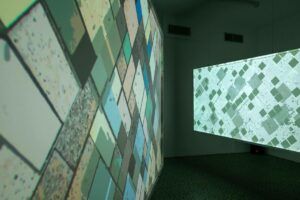Nayda Collazo-Llorens (b.1968, San Juan, PR) is an artist based in Michigan who works on paper, canvas, video, installation, site-specific and public art projects. The core themes of her practice include the complexities of virtual noise, dislocation, memory, and mapping mainly through an abstraction art language. “Memory of movement” can better attempt to define her work at large. Her artistic strategies include abstraction, mapping, sampling, overlapping, memory, and archiving.
How does Nayda Collazo-Llorens’ use of digital noise and abstraction challenge traditional notions of memory and representation? The artist’s use of abstraction places her within a lineage of Latin American artists who have used non-representational forms to explore identity, politics, and memory. Artists like Gego and Mira Schendel also challenged traditional notions of geometric abstraction by incorporating personal, cultural, and ephemeral elements into their works. Caribbean artists, such as Teresita Fernández, also engage with the region as a site of complex histories, migrations, and hybrid identities. Collazo-Llorens’ work reflects these dynamics by treating the Caribbean not as a fixed geographical location but as a layered, imagined space shaped by colonial histories and diasporic movements.
In her layered visual language, Collazo-Llorens reflects the complex geopolitics of the Caribbean, where borders and identities are in constant flux. The Caribbean Sea, which appears in the piece De pasada y a través (2023), becomes a symbol of both connection and separation—an ever-shifting space that mirrors the diasporic experience. Her act of creating fictional maps and fragmented landscapes critiques the erasures and distortions inherent in colonial cartography by echoing postcolonial critiques of knowledge systems. The abstraction and dislocation in her work could also be seen as engaging with Antonio Benítez-Rojo’s “repeating island” theory. In his book La isla que se repite (The Repeating Island) (1998), the author conceptualizes the Caribbean as a space of endless repetition, rupture, and recomposition.
Collazo-Llornes incorporates digital media, animated videos, and sound in her work, positioning her within the broader tradition of new media art which emerged in the late 20th century. In her video installations, she explores the overload of digital information and noise, transforming it into a metaphor for the diasporic experience. Resonating with artists who interrogate the relationship between humans and technology, such as Olafur Eliasson, Collazo-Llorens includes a focus on diasporic fragmentation and dislocation.
The artist frames digital memory and virtual noise as metaphors for her diasporic experience. In her digital landscapes, Collazo-Llorens navigates the data and noises symbolizing how Puerto Ricans in the diaspora shift through fragmented memories and histories. The three-channel animated video installation, Rupturing (2021), ruptures experiences for the viewer, breaking the boundaries of traditional narrative structures. Three double-sided screens can be seen on the front and reverse side, positioned in a non-parallel way. The viewer can walk in front, between and behind the pieces having an immersive experience just as required by everyday life. The artwork includes sound, visual and text and originates from one or two drawings by the artist. Is divided into three chapters: Navigation, Dislocation, and (Dis)connections. Themes like rupture or collapse, vibration, movement, transformation, and the impossibility of capturing everything at once ties the artwork to the diasporic experience of fragmentation and dislocation.
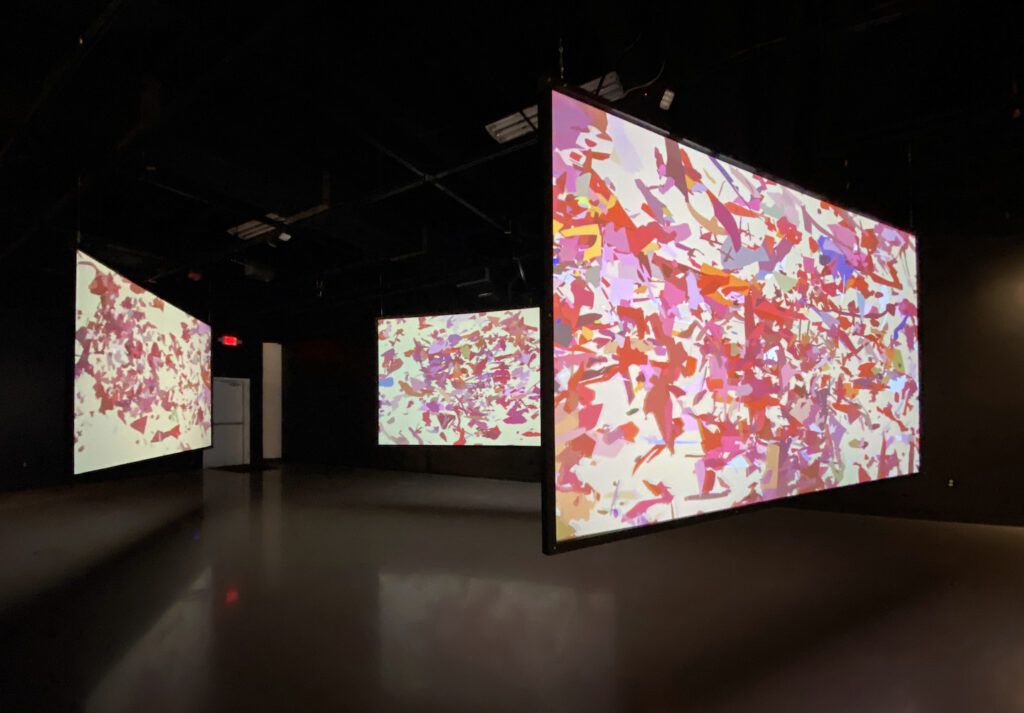
Collazo-Llorens’ works on mapping, particularly Island Mappings (2018– ) and her series of topographical studies, explore Puerto Rican landscapes as layered, dimensional spaces shaped by migration and colonial histories. The ongoing series of watercolor and ink drawings began in 2018. By using fragmented archives and maps to evoke a sense of loss and retrieval, she underscores the limitations of traditional historical records in capturing diasporic narratives. Her use of abstraction, sampling, and layering create an archive of Puerto Rican history that is incomplete and constantly in flux. These fictional mappings are created from cropping and pasting of “real” maps. With invented dimensionalities and topographies, the artist creates areas of interest and of possible attack. It seems as if the creative process is a play of imaginary conquests of a past or future life. Therefore, her practice can be contextualized in postcolonial narratives.
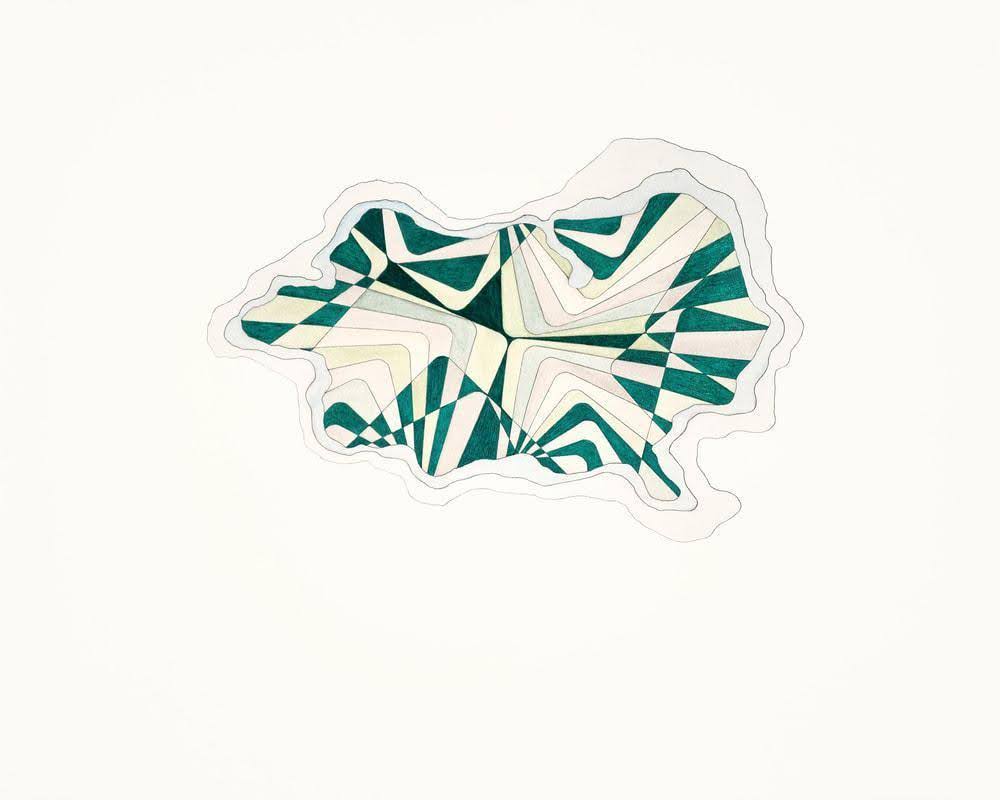
De pasada y a través (In passing and through) (2023) is a two-channel video installation with doubled-sided screens and audio. It was produced for a solo exhibition at El Lobi in San Juan, PR. Santurce, a neighborhood in San Juan where the artist grew up, is the focus. The abstraction has an unspecified topic. The squares that appear on view in the artwork remind of the historical tiles from Spanish Revival architecture that can be seen at the gallery as well as the house of the artist’s late grandparents. The visuals are interrupted by a red flag, a representation of rip currents that bring you in and take you out. Text is incorporated and related to the sound of wind. The next part makes you think of turning the pages of a book, of flight. The squares can also represent a migratory transport: the airplane. An overlapping of mythical beings and the sound of water suggest the viewer an aerial scene. When traveling towards and out of Puerto Rico on an airplane, one can see similar visuals: the Caribbean Sea and islands that appear from time to time.
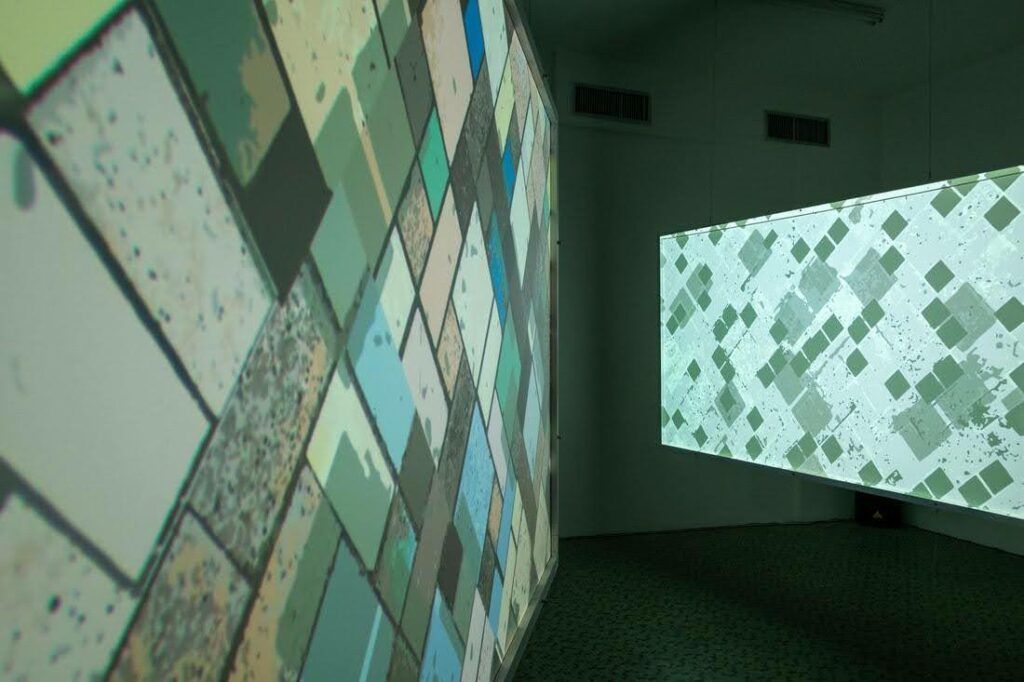
Debajo de la casa (Underneath the house) (2023) is a site-specific project produced for El Cuadrado Gris / The Gray Square, an alternative art space located in the basement of a house in Santurce. The artist’s queer and diasporic identity is explored and highlighted in how her work “breaks the architecture,” both literally and figuratively, challenging conventional structures. The tower of books come from the personal collection of her grandfather: a writer and linguist. With it, Collazo-Llorens engages with archival memory, as seen in her references to family histories and ancestral knowledges. One cannot read the titles or contents of the books, touching on the impossibility of knowing all, a repetitive theme in the artist’s trajectory. The artwork includes a small video of a light bulb turning on and off seeming like a coded message. The painted shadow-like forms activate the walls, columns, and ceilings of the basement. At large, Collazo-Llorens’ work references spaces of movement and transience, such as the lobby, the tiles, and the basement. They tie with larger themes of migration, cultural memory, and identity.
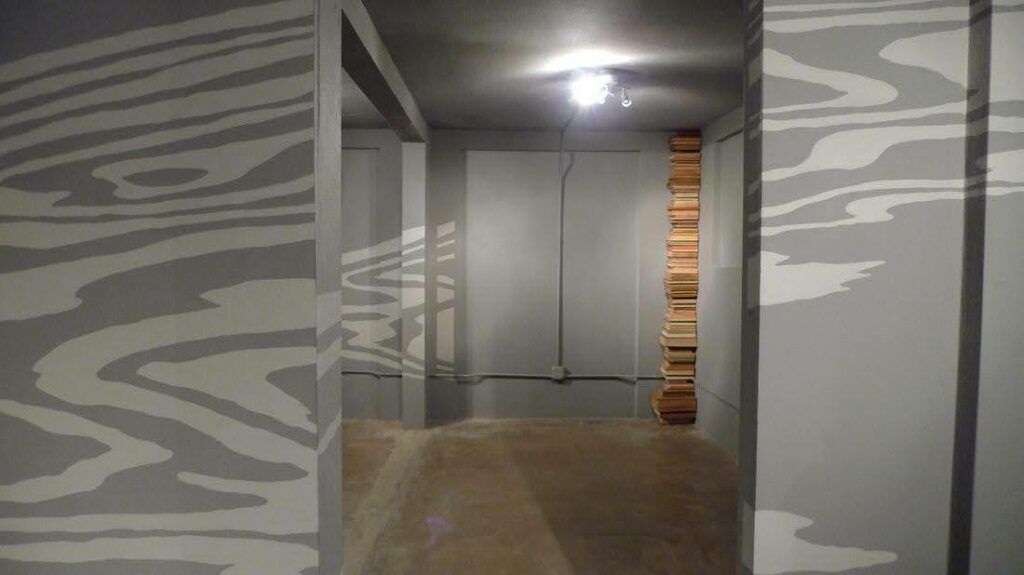
El Cuadrado Gris, San Juan, PR. Image courtesy of an artist.
The artist often transforms physical spaces into immersive experiences, encouraging viewers to navigate her work in ways that mirror the fragmented and dislocated nature of diasporic identity. In Rupturing, the non-parallel arrangement of the screens and the ability to walk in front of, between, and behind them emphasizes movement and interaction. This spatial arrangement disrupts traditional modes of viewing and reflects the fluid, shifting experiences of migration and dislocation. Similarly, her site-specific installation Debajo de la casa breaks the architecture of the space, activating walls, columns, and ceilings with shadow-like forms. The basement setting, a space of transience, storage, and hidden narratives, further underscores themes of memory and the unseen, tying the physical space to cultural and personal histories.
Her digital works expand the notion of space beyond the physical, addressing how the virtual realm has become an extension of diasporic existence, where individuals navigate between multiple cultural and geographical contexts. Her works are multisensory, combining visuals, sound, and movement. The use of sound, the wind for example, adds another dimension to the space, reinforcing the idea that diasporic memory and identity cannot be fully understood through visual means alone. These immersive environments create spaces that engage the viewer’s body and senses, emphasizing the embodied nature of diasporic experience.
Some themes to emphasize are noise and navigation, mapping and disconnection, queer diasporic identity and archives and ruptures. The role of digital and virtual noise function as a metaphor for dislocation and fragmented memory, while abstraction and mapping are tools to explore physical and cultural displacement. The intersection of queer identity with diasporic experiences can be seen particularly through embodied practices of touch and movement. Memory, family histories, and Puerto Rican identity can be approached through fragmented, multi-layered approaches.
Collazo-Llorens’ practice continues to evolve using technology, abstraction, and sound to explore Puerto Rico’s past and future. Her fictional mappings create dimensional, layered spaces that exist in flux, much like the identities and memories they represent. These maps become spaces of potentiality, inviting viewers to consider alternative narratives and relationships to place. By engaging with space on multiple levels—physical, conceptual, virtual, personal, and geopolitical—Collazo-Llorens creates works that are both deeply rooted in specific contexts and expansive in their exploration of universal themes. Her approach challenges traditional understandings of space, offering instead a fragmented, layered, and dynamic perspective that reflects the complexities of diasporic identity and memory.
A selection of further questions that arise when reflecting on Nayda Collazo-Llorens’ work include: In what ways does her mappings and cartographic explorations critique colonial histories and propose alternative narratives of Puerto Rican identity? How does the focus on family histories and ancestral knowledges contribute to a broader understanding of diasporic and postcolonial memory? In what ways does her work intersect with queer identity, migration, and cultural memory through spatial and embodied practices? How does the viewer’s physical movement within her installations reflect the fragmented, non-linear nature of diasporic experience? While this text does not entail a comprehensive research on Nayda Collazo-Llorens’ artistic trajectory, it seeks to approach the reader with an invitation to continue learning about her practice.
References
- Benítez Rojo, Antonio. 1998. La isla que se repite. Editorial Casiopea.
https://archive.org/details/laislaqueserepit0000beni/page/418/mode/2up. - Collazo-Llorens, Nayda. 2024. Unpublished Interview by Ana Hilda Figueroa de Jesús.
September 7. - Collazo-Llorens, Nayda. 2024. “Nayda Collazo-Llorens.” Accessed on September 30.
https://www.naydacollazollorens.com/.
